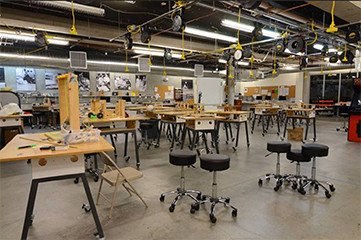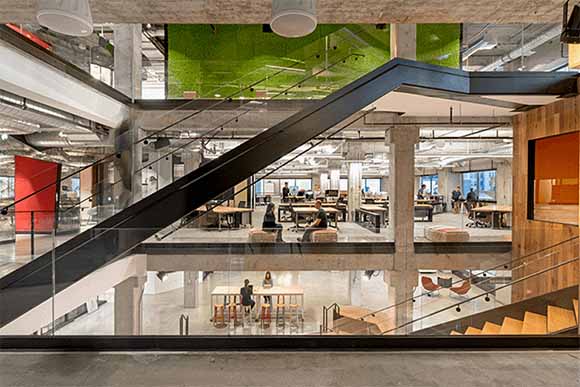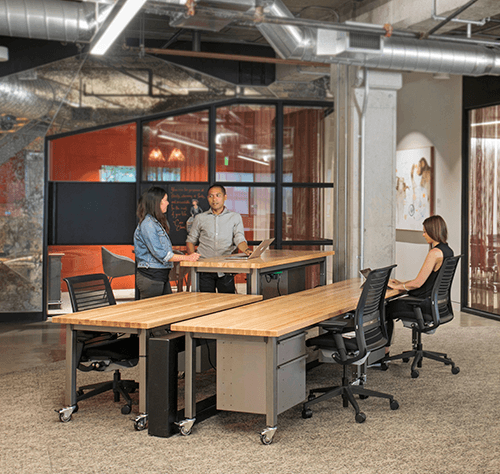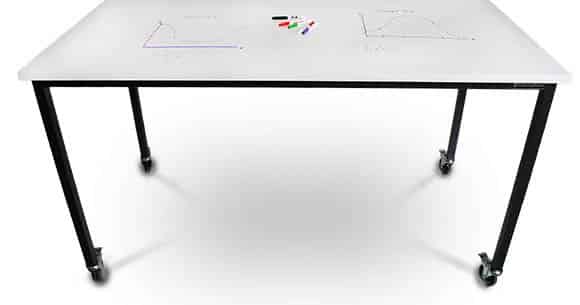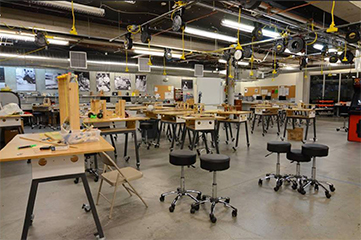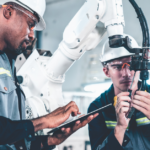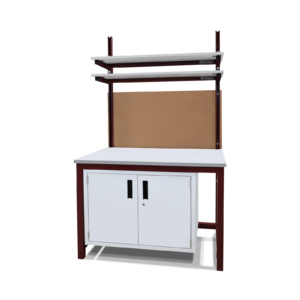More and more classroom designs are moving away from traditional, teacher-focused classrooms (with desks lined up neatly in a row) toward open, flexible layouts with furniture designs that support technology-enhanced learning and student-led group projects. If you’ve kept up with the latest changes in modern office design, you’ll see many similarities to the way that new workspaces have moved away from regimented office cubicles toward more open, collaborative environments. Let’s take a look at how these new classroom interior design ideas work in practice.

Classroom Design is Undergoing Major Change to Get the Most Benefit From New Education Technology
If you could build a new school from scratch, would you follow a traditional classroom design layout or would you opt for something completely new?
The rural school district in Eminence, Kentucky faced a choice. Their school district was failing and the small town was declining along with it. Superintendent Buddy Berry, a 4th generation alum of the school, sought to make a radical change: he led the effort to engage his students in building a brand new facility that would focus on personalized learning and help students prepare for college.
The new 30,000 sq ft school, dubbed the EDhub, wraps around a central core, where students ages K through 12 grade assemble for different classroom activities. Unlike traditional school designs, the EDhub space is incredibly open, providing a feeling of community which is further enhanced by the large expanses of glass window walls. Hallways wrapping around the core incorporate impromptu meeting spaces, just like the latest office designs.
The small, lower-income community elected to raise its own property taxes to fund the $6 million dollars needed for the new school. But their investment in the future is already paying dividends. Rather than shrinking, enrollment in the school has doubled. Whereas only 20% of Eminence students went on to college before the new facility was built, now 99.5% of the students enrolled in the college prep studies are on track to graduate from university.
What is Blended Learning and How is it Changing Classroom Design?
There’s a lot to unpack in the Eminence EDUhub video above.
For example, while many leading schools or libraries are thrilled to have one Makerspace at their facility, the Eminence school has eight separate Makerspace labs, including a robotics lab, a bio lab, a design thinking lab, TV production studio lab, and a tool shop lab.
Makerspaces promote hands-on learning by allowing students to learn about current technology by creating projects that reinforce STEM (science, technology, engineering, mathematics) skills that they are learning in school. These projects, which can range from building Internet of Things-powered robots to more traditional woodshop and sewing projects, are often organized by the students themselves.

This brings us to the classroom design layouts at Eminence. What’s different there?
Like many new schools, their classrooms are designed for maximum flexibility. Not only can the furniture be moved around easily, so can the wall divider units, making it easy to create layouts for specific functions, such as student group projects or classroom presentations. Compared to traditional classrooms with all the desks lined in a row facing the teacher, it looks more like the interior of the latest Silicon Valley startup rather than a primary or secondary school classroom.
What’s the reason for the shift in classroom design after all these years?
The answer is there is a revolution going on in education right now.
It’s driven by a desire to take advantage of new technology to help the students learn on their own or by working in groups.
In this new philosophy, students learn by working together with other students on group projects, as well as spend time outside the classroom learning new material. Teachers no longer spend all their time giving lectures to students; instead, they use their time in the classroom to facilitate student projects, answer questions, and assess each student’s progress, often by receiving individual and group presentations from students.
This new approach goes by a lot of different names:
- Personalized Learning
- Integrative/Integrated Learning
- Blended Learning
- Flex
- Flipped Classrooms
In this article, we’ll use the term blended learning to describe this new educational approach.
Now a little history. Where did blended learning come from?
The term itself dates back to at least 2006 when C.J. Bonk and CR. Graham published their book The handbook of blended learning environments: Global perspectives, local designs. Nancy Van Note Chism at Indiana University has also written extensively on the topic, including her work in The Importance of Physical Space in Creating Supportive Learning Environments, co-edited with D.J. Bickford.
There is also the wonderful, self-deprecating story told by grass-roots education innovator Esther Wojcicki, a pioneering English and Journalism teach at Palo Alto High School in Silicon Valley. Wojcicki wrote a grant in 1984 to acquire eight of the first-generation Macintosh computers for her classroom. In the TEDx video below she explains how she was able to change her teaching approach to allow students to learn journalism by doing it themselves — by making newspapers, magazines, and video programs of their own creation.
Today the Palo Alto High School journalism has 500 students and publishes ten award-winning, student-produced publications. As the program has grown, there are now five journalism teachers, but Wojcicki often has as many as 80 students in her classroom at one time. This has only been possible by changing (or “flipping”) the classroom around where students work in self-directed groups, coming to Wojcicki for assistance and guidance.
What Do Modern Blended Learning Classroom Designs Look Like?
If you’re familiar with the latest trend in office design, with their open spaces, comfortable seating, easily reconfigurable furniture, spaces for impromptu meetings, and places to collaborate together on projects, the newest classroom designs will seem very familiar to you.
And there’s a reason for that. Office space planners are constantly looking for ways to make office designs more productive and to take advantage of the way the people want to work today using mobile technology, such as smartphones and tablets. There’s no need to be tied down to your cubicle or desk at a fixed PC workstation when you can move to the couch to read on your tablet, or to meet a colleague in the cafeteria to review reports, or confer with your colleagues at an overseas office in the telepresence conference room.
Education curriculum planners are facing similar challenges when it comes to introducing the positive aspects of technology into their educational programs. As new technologies have become available, there’s been a lot of trial and error to discover the right mix, e.g. deciding how and when students should spend their time on a computer-based learning program or watching an interactive video.
The emerging consensus, as exemplified by blended learning, is to flip the classroom around. Students are becoming more responsible for their own learning progress and the teachers are there to help facilitate and make corrective course changes as needed.
As a result, the interior of blended learning classrooms tends to look quite different; they include many the features found in modern office design including:
1. Flexible Desk Furniture:
In today’s classrooms desks are mounted on lockable rollers so they can be re-positioned to form new configurations throughout the day as students work together on different projects.
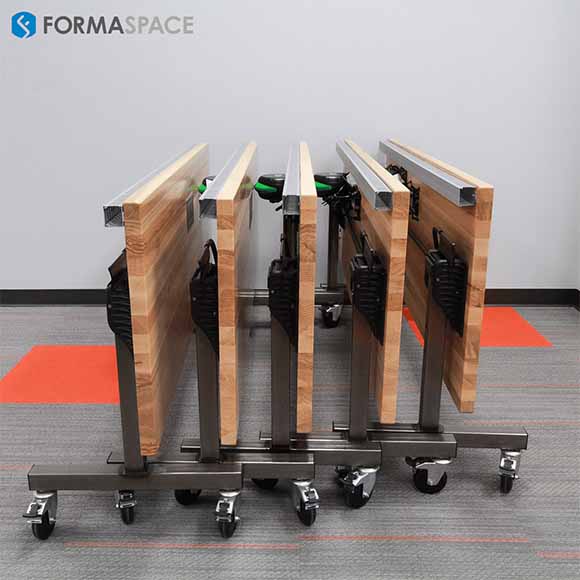
2. Collaborative Workspaces:
Student group projects are an important component of today’s blended learning programs. Large worktables can be rolled into place, allowing students to work together. Formaspace also offers designs where the work surfaces can be raised or lowered to accommodate different age children. We also offer worktables with surfaces that can swing upwards to a vertical position, to create a presentation space where students can showcase their work.
3. Movable Room Dividers
Flexibility is a key concept in blended learning classrooms. Safe, stable movable room dividers can help organize your space in new ways. Incorporating erasable chalkboard or whiteboard surfaces can make these mobile room dividers even more useful.
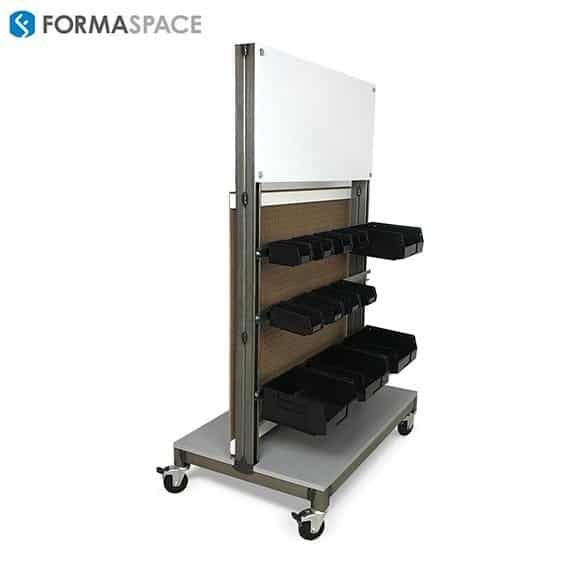
4. Comfortable Seating
Just like adults, young children want to move around and stay active throughout the day. Reading at your desk can be uncomfortable for long periods of time. Many classrooms now offer comfortable seating areas for reading where you can curl up on a soft couch or on unconventional seating, such as a beanbag chair or low cushion.

5. Presentation Areas
Teachers need to be able to provide formative (in process) and summative (final) assessments of their students during the school year in order to help them improve their educational outcomes. Individual student and group project presentations provide an ideal way for teachers to understand whether students learned their subject areas or not. Some blended learning classrooms have small presentation areas set aside with couches and computer monitor that allow small groups to present to the teacher. In other cases, large format presentation screens allow students to present to a wider audience.

6. Quiet Areas
Open areas with many people talking at once can be noisy, making it hard to concentrate on tasks such as reading. Many blended classroom designs now provide quieter areas that allow students to concentrate on projects or their reading materials.
7. Learning Zones
Computer-based learning can allow students to focus on those areas where they are having difficulty. These can be located within classrooms in special learning zones or they may be set up in dedicated computer labs nearby.

8. Makerspaces
While many student projects can be accomplished in the classroom by moving desks together or gathering at dedicated collaborative workspaces, more involved projects that require the use of specialized tools, or make loud noises are better accommodated in dedicated Makerspaces. See our guide for creating a space in your school or library.
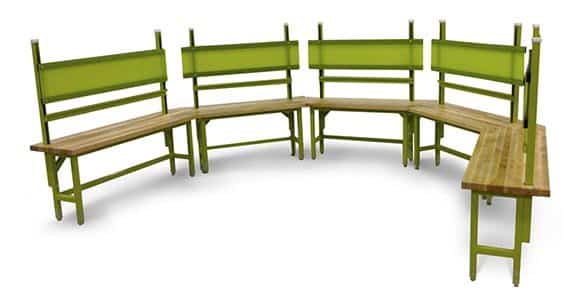
Flexible Classroom Designs Help Students Be More Engaged in School
Do blended learning classrooms get results?
There are encouraging signs that they are. For example, the University of Minnesota found that their students were nearly 50% more likely to participate in classroom discussions when the classroom layouts were changed from traditional lecture style seating to collaborative group seating. Test scores also went up as well.
The education group Raise Your Hand Texas, is also helping five school districts in Texas through its Raising Blended Leaders Initiative, including Birdville Independent School District (ISD), Cisco ISD, KIPP Houston, Pasadena ISD and Point Isabel ISD. They are also working with the Harlingen Texas school district in the Rio Grande Valley near the border with Mexico.
Like Eminence, Kentucky, Harlingen is not a well-to-do area. So the investment made by the school district comes at a high cost to the local community, but indications are that the investment is paying off, as you can see in this video:
According to Dr. Arturo Cavazos, Superintendent, Harlingen CISD, they engaged over 800 community members to find out what their aspirations were for their children. Community members responded they wanted their kids to be able to take on the challenges of this world. So Harlingen CISC is implementing job internships in partnership with area employers. They also created a firefighting academy, a health science program, a teacher academy, a media arts and communication academy, and a transportation and logistics academy to meet the needs of their students.
Join Us and Be Part of the Classroom Design Revolution
Are you ready to be part of the solution?
We’re ready to help.
Formaspace has the experience you need to help build the right classroom and Makerspace solutions for your educational institution.
From sit-to-stand desks to movable collaboration tables, Makerspaces, and cafeterias, Formaspace is your furniture education partner.
All of our products are of the highest quality, American-made in our Austin, Texas headquarters and backed up by our no-questions-asked, twelve-year guarantee.
Learn more today. Contact your Formaspace Consultant for a free consultation. Just fill out the quick contact form below.


